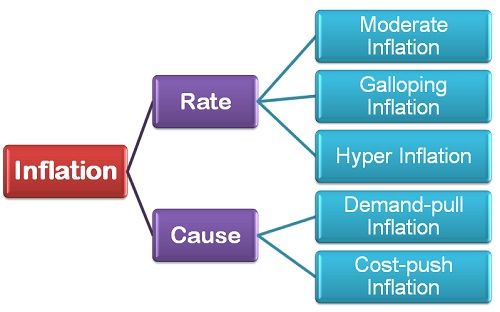Definition: Inflation refers to the persistent rise in the general price level of goods and services.
Types of Inflation
 Types of Inflation: On the Basis of Rate
Types of Inflation: On the Basis of Rate
- Moderate Inflation: The moderate inflation, also called as Creeping Inflation refers to a single digit annual increase in the general price level. During the moderate period, the price increases persistently, but at a mild or moderate rate, i.e. less than 10% or a single digit inflation rate. A moderate rate may vary from country to country, but however an important trait of this inflation rate is, it is predictable.
- Galloping Inflation: The galloping inflation refers to the exceptionally high inflation rate that leads to an increase in the general price level. Generally, the inflation is in double or triple digit and is reflected in the high price of goods and services, i.e. prices increase manifold. The double-digit inflation varies from 10% to 999% per annum and there is a great difference between these two limits. A country with 900% inflation will have more devastating effects than the one having 20-30% inflation.
- Hyper Inflation: As the name suggests, the hyper inflation is the situation when the prices rise at an alarmingly high rate, i.e. more than a three-digit per annum. The prices rising above 1000% per annum marks the beginning of hyper inflation. During this period, the paper currency becomes worthless, and people start trading in kind, such as gold and silver and often resort to the old barter system of commerce.
Types of Inflation: On the Basis of Cause
- Demand-pull Inflation: The demand-pull inflation exists when the aggregate demand increases rapidly than the aggregate supply. In other words, for a given level of aggregate supply the aggregate demand increases manifold, then the demand-pull inflation occurs. This increase in the demand can be due to the monetary factors i.e., increase in money supply and real factors, Viz. Cut in tax rates, increase in government expenditure, upward shift in investment function, etc.
- Cost-Push Inflation: The Cost-Push inflation occurs when the cost of raw material, labor, and inputs necessary for the production of final goods increases. Such inflation is often caused by the monopolistic groups of the society such as labor unions and firms in the monopoly and oligopolistic market setting.
Strong labor unions force the wage price to go up that leads to an increase in the price of goods and services. This rise in the price level is called as wage-push inflation. Also, the firms enjoying the monopoly in the market raise the price level to increase their profit margins due to which the general price level increases. This is called as profit-push inflation. Another kind of cost-push inflation is the supply-shock inflation when the firms restrict the aggregate supply of goods and services.
Thus, one may conclude that inflation is either caused due to its rate and cause, thereby leading to a sustainable increase in the general price level in the economy.

calvin owino says
thanks for the notes,was really helpfull